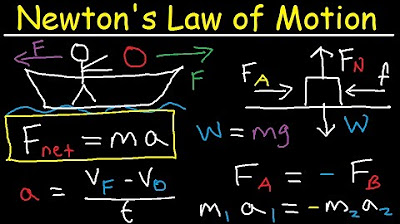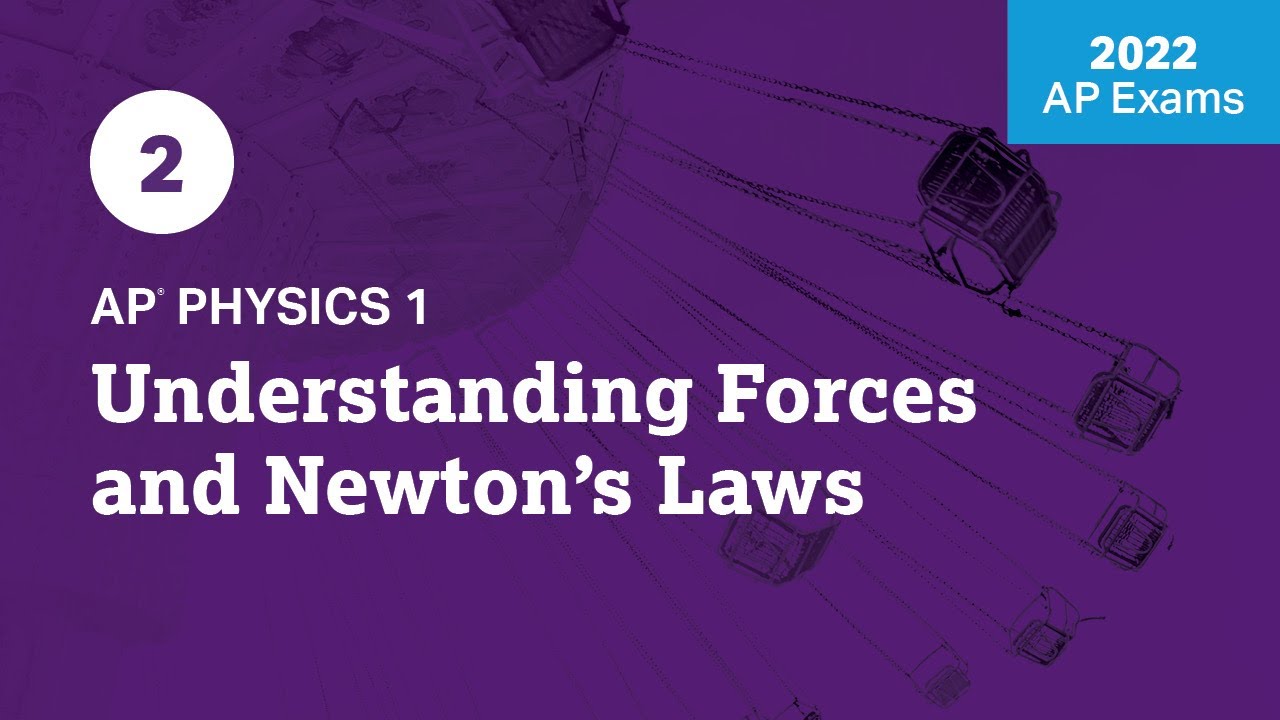8.01x - Lect 6 - Newton's Laws
TLDRIn this engaging lecture, the fundamental concepts of Newton's Laws of Motion are explored with clarity and enthusiasm. Starting with the law of inertia, the discussion progresses through Newton's First, Second, and Third Laws, illustrating how forces and accelerations interact within inertial frames of reference. The lecture also delves into practical examples, such as the tension in strings and the unexpected outcomes of a string-breaking experiment, emphasizing the importance of understanding and applying these foundational principles of physics.
Takeaways
- 📜 Newton's First Law (Inertia) states that an object at rest stays at rest, and an object in motion continues in motion at a constant velocity unless acted upon by an external force.
- 🌌 The First Law doesn't hold in all reference frames, especially those that are accelerating, such as a rotating or orbiting body.
- 🚀 Newton's Second Law quantifies force as the product of mass and acceleration (F=ma), and it is fundamental to physics, applying in inertial reference frames.
- 🔢 The Second Law is derived from experimental observations, such as the consistent relationship between the force applied to a spring and the resulting acceleration.
- 🌍 Newton's Third Law states that for every action, there is an equal and opposite reaction, meaning forces between interacting objects are equal in magnitude and opposite in direction.
- 💡 The Third Law implies that forces are mutual; when one object exerts a force on another, the second object exerts an equal force back on the first.
- 🌐 The Third Law applies universally, regardless of whether objects are moving or at rest, and is evident in everyday experiences like pushing against a wall or walking.
- 🎢 An example of the Third Law in action is the operation of a rocket, where the expulsion of gases in one direction results in the rocket being propelled in the opposite direction.
- 📐 A practical demonstration of Newton's Laws can be seen in a setup with an object suspended by two strings at angles, where the tensions in the strings can be analyzed using the Laws.
- 🔼 The concept of action and reaction is so fundamental that even the Earth experiences a minuscule 'fall' towards a falling object due to the gravitational pull between them, as described by the Third Law.
- 🧪 Experiments demonstrating the laws of motion, such as measuring tension in strings, can provide insights into the principles of physics, even if the results are not always as expected.
Q & A
What is Newton's First Law of Motion?
-Newton's First Law, also known as the law of inertia, states that an object at rest stays at rest and an object in motion continues in motion with the same speed and in the same direction unless acted upon by an unbalanced force.
Why does Newton's First Law not hold in all reference frames?
-Newton's First Law does not hold in non-inertial reference frames, which are frames that are accelerating. In an accelerating reference frame, objects appear to experience forces even when no actual forces are acting on them due to the acceleration of the frame itself.
What is the definition of an inertial reference frame?
-An inertial reference frame is a frame of reference in which an object not subjected to any external force will maintain its state of rest or uniform straight-line motion. It is a frame without accelerations of any kind.
How does the Earth's rotation and revolution affect the concept of an inertial reference frame?
-The Earth's rotation on its axis and its revolution around the Sun introduce centripetal accelerations, which means that locations on Earth, including lecture halls and laboratories, are not perfect inertial reference frames because they are subject to these accelerations.
What is Newton's Second Law of Motion?
-Newton's Second Law states that the acceleration of an object is directly proportional to the net force acting on it and inversely proportional to its mass. It is often expressed with the formula F = ma.
Outlines
📚 Introduction to Newton's Laws
The video begins with a discussion on acceleration, transitioning into Newton's Laws. It introduces the first law, the law of inertia, highlighting its origins with Galileo and its restatement by Newton in the Principia. The lecturer explains the law's counterintuitive nature against daily experiences due to gravity and friction, and asserts that in the absence of forces, an object in motion would continue indefinitely in a straight line. The video also touches on the concept of an inertial frame of reference and its relevance to the first law, using examples of the Earth's rotation and revolution around the Sun to illustrate the complexities of applying the law in non-inertial frames.
📐 Newton's Second Law and the Concept of Force
The second law of motion is introduced, focusing on the relationship between force, mass, and acceleration. The lecturer uses a spring and mass system to demonstrate experimentally how the force exerted by a spring is proportional to the mass and the resulting acceleration. The law is expressed as F=ma, with the unit of force named 'newton' in honor of Newton. The video emphasizes that the second law, like the first, is only valid in inertial reference frames. The lecturer also addresses the limitations of Newtonian mechanics at speeds approaching the speed of light, where Einstein's theory of special relativity becomes necessary.
🤔 Objections and the Determination of Mass
The lecturer addresses potential objections to the concept of mass and force, explaining how mass can be determined without the use of gravity. Using the example of two identical pieces of cheese in outer space, the lecturer illustrates that mass can be understood as the total number of molecules or atoms, independent of gravitational force. The video also discusses the gravitational force as a linear function of mass and uses this to explain the net force on an object at rest in an inertial frame, such as the ball in the lecturer's hand, which must balance the gravitational force with an equal and opposite force from the hand.
🚀 Newton's Third Law: Action and Reaction
Newton's third law, which states that for every action, there is an equal and opposite reaction, is introduced and explained with various everyday examples. The lecturer emphasizes that this law always holds, regardless of whether objects are moving or accelerated. The video demonstrates how the contact force between two objects is the same in magnitude but opposite in direction, using the example of a system of two masses connected by a force. The lecturer also presents a simple calculation to show how the forces and accelerations relate in such a system, reinforcing the concept that the third law applies to all interactions, even if the forces are too small to measure directly.
🌍 The Earth's Minute Movement Due to Newton's Third Law
The video delves into the implications of the third law on a large scale, considering the Earth's response to the force exerted by a falling object. It humorously exaggerates the idea that the Earth, the lecturer, and the audience are all falling towards the ball when it falls, due to the equal and opposite force the Earth exerts on the ball. The lecturer then presents a thought experiment where the Earth is considered to fall towards the ball, calculating the Earth's minuscule acceleration and位移, highlighting the conceptual beauty of the law, even if the actual movement is too small to measure.
🧪 Practical Demonstration of Newton's Laws
The lecturer conducts a practical demonstration involving two strings supporting a weight, with the strings arranged at different angles to the vertical. The aim is to calculate the tensions in the strings using Newton's laws. The lecturer presents a method involving decomposing forces into x and y components and solving the resulting equations, offering an alternative geometric approach using trigonometry. The demonstration includes an attempt to measure the tensions with spring scales, highlighting the challenges and inaccuracies involved in such experiments.
🔴 Tension Experiment: Breaking Strings
The video concludes with a dramatic experiment where the lecturer tests the students' understanding of Newton's laws by predicting which of two nearly identical strings will break first when the tension is increased. After an unexpected result and a second attempt, the lecturer reinforces the importance of experimental verification and the iterative nature of scientific inquiry. The video ends with a reminder to ponder the experiment's outcome and an encouragement to see the next lecture.
Mindmap
Keywords
💡Acceleration
💡Newton's Laws of Motion
💡Inertia
💡Force
💡Mass
💡Reference Frame
💡Centripetal Acceleration
💡Gravitational Force
💡Action-Reaction Pairs
💡Tension
💡Hero's Engine
Highlights
Introduction to Newton's Laws, which are fundamental to understanding motion and forces.
Newton's First Law, also known as the law of inertia, states that an object at rest stays at rest and an object in motion continues in motion with a constant velocity unless acted upon by an external force.
The concept of inertial reference frames and how Newton's First Law does not hold in all reference frames, particularly those that are accelerating.
Explanation of how the Earth's rotation and revolution around the Sun contribute to centripetal acceleration, affecting the applicability of Newton's First Law.
Newton's Second Law introduces the concept of force as the product of mass and acceleration (F=ma), and its importance in physics.
Demonstration of how the force exerted by a spring on an object is directly proportional to the mass of the object and the extension of the spring.
Discussion on the limitations of Newtonian mechanics at speeds approaching the speed of light, where Einstein's theory of special relativity becomes necessary.
Newton's Third Law, which states that for every action, there is an equal and opposite reaction, and its implications in everyday phenomena.
Illustration of Newton's Third Law through examples such as pushing against a wall, the recoil of a gun, and the motion of a garden hose spraying water.
The concept of 'contact force' and how it applies to the interaction between two objects, always being equal in magnitude and opposite in direction.
A detailed example of calculating tensions in strings using Newton's Laws, involving an object suspended from two strings at different angles.
The experimental setup and results of measuring tensions in strings, highlighting the challenges in accurate measurement and the practical application of theoretical concepts.
An unexpected outcome from a string tension experiment, where the predicted string to break first did not, prompting a reevaluation of the assumptions and a second attempt.
The importance of experimental verification of theoretical predictions in physics, as demonstrated by the repeated string tension experiments.
The conclusion of the lecture with a reminder to think about the concepts discussed, emphasizing the practical and theoretical significance of Newton's Laws.
Transcripts
Browse More Related Video

How to Cram Dynamics in 1.5 hours (AP physics 1)

Newton's Laws of Motion

Newton's Law of Motion - First, Second & Third - Physics

2022 Live Review 2 | AP Physics 1 | Understanding Forces and Newton’s Laws

AP Physics 1 review of Forces and Newton's Laws | Physics | Khan Academy

College Physics 1: Lecture 13 - Motion and Forces
5.0 / 5 (0 votes)
Thanks for rating: